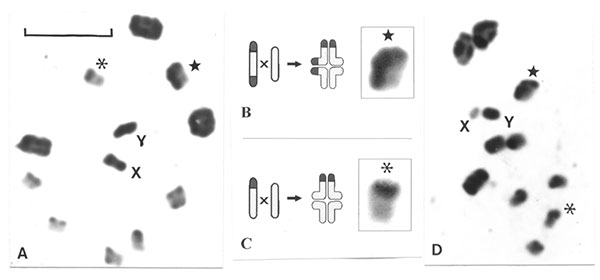Volume 10, Number 3—March 2004
Research
Genomic Changes of Chagas Disease Vector, South America
Figure 4

Figure 4. Meiotic pairing in the experimental male hybrid progeny between Andean and non-Andean specimens of Triatoma infestans. Scale bar = 10 μm. A: First meiotic metaphase in an insect obtained by crossing a female from Andean region (with C-banded X chromosomes) with a male from non-Andean region. As expected, both sex chromosomes are heterochromatic. As observed in normal specimens, the ten bivalents form a ring with the univalent sex chromosomes in the middle. Chromosome pairing was normal even between chromosomes with great heterochromatic differences. B: Selected bivalent with a diagram of its mitotic and meiotic configuration. As generally observed in hemipteran insects, only a single chiasma is represented. Chromosomes involved in the pairing have different C-patterns: one has C-bands in both chromosomal ends (B-morph); the other one is completely euchromatic (C-morph); the resulting bivalent is asymmetric. C: Selected bivalent with a diagram of its mitotic and meiotic configuration. Chromosomes involved have different C-patterns: one has C-bands in only one chromosomal end (A-morph) while the other one is completely euchromatic (C-morph); the resulting bivalent is also asymmetric. D: First meiotic metaphase in an insect obtained by crossing a female from non-Andean region (with euchromatic X chromosomes) with a male from Andean region. As expected, the X chromosome appears euchromatic in the hybrid. Chromosome pairing was completely normal even between chromosomes with great heterochromatic differences.